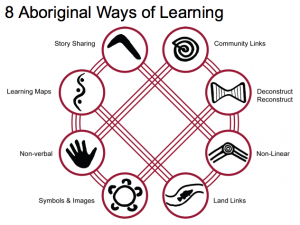8 Aboriginal Ways of Learning
This is a VERY short visual look at ways that allow teachers to include Aboriginal perspectives by using Aboriginal learning techniques. It is presented by “Australian Policy Online”. I liked the visual.
http://apo.org.au/website/8-aboriginal-ways-learning
October 6, 2011 No Comments
eLearning in Small Remote Aboriginal Communities
This online presentation looks at ways to enhance success for high school students engaged in web-based learning in Canada. It looks at areas identified that need improving (organizational, communications, motivation, and contextual). Key issues are addressed, and then strategies for improvement are given.
October 6, 2011 No Comments
Online Learning Environments for Indigenous Cultural Inclusivenss
Laurel Dyson published “Constructing Shared Online Learning Environments for Indigenous Cultural Inclusiveness” (2003). It looks at some of the challenges for online learning for Aboriginal students and identifies several conditions for effective delivery. Some of the key conditions include:
- Flexibility
- Interactivity
- Minimal text
- Cultural appropriateness
- Indigenous-specific virtual space
- Optional customization for individual learners
The paper looks at several previously completed studies to support these conditions.
October 6, 2011 No Comments
Checklist for Developing Indigineous eLearning Resources
Presented by the Australian Flexible Learning Framework, this document is a great resources for preparing eLearning resources for Aboriginal students. Some of the topics included are:
- Cultural Protocols
- Indigenous Partnerships
- Technology
- Cultural Inclusively
- Delivery
- Other Useful Resources
I liked the documents preface:
“It is important that the developers of Indigenous online learning resources acknowledge that Indigenous Australians are part of diverse nations. There are approximately 90 surviving languages and 20 of these with distinct associated cultures. Because of this diversity, any resources that are developed for Indigenous users should be developed in partnership with local Indigenous communities to ensure that the resources have been tailored for the specific community in which they are based as well as being able to be used by Indigenous communities in other areas. Cyberspace itself has a culture and is not a neutral or value-free platform for exchange.”
October 6, 2011 No Comments
Statement Connecting Weblog to Research Interests
The College of the Rockies (COTR) serves the communities of the East Kootenays and is located in the traditional territory of the Ktunaxa Nation and the Kinbasket people. Five Bands are located within the College region, four Ktunaxa Bands and one Shuswap – Kinbasket Band.
I teach in the Child, Youth, and Family Studies program at COTR, and while there is a strong Aboriginal presence in our institution, it is strangely absent in my department. Last year the Aboriginal Strategic Support and Education Team (a team of faculty members whose goal is to “work collaboratively with the College community to promote the integration and use of Aboriginal scholarship in programs and courses offered by College of the Rockies”) approached our department requesting we include more Aboriginal content in our courses. The request was denied, as my department felt we were very multi-cultural in our approach, and that it was not necessary to single out any one specific culture or group of people. Although very early in this course, I’m already realizing that there are deeper issues that we never considered. There are distinctions to be made and questions to be asked.
Why do we have almost no First Nations students enrolled in our program? Many of the courses I teach are online courses. What can I do, as an instructor, to meet the needs of Aboriginal students in my online classes? What are those needs? How are the goals and needs of Aboriginal students taking online courses different and/or similar to non-Aboriginals’? These are the questions I will use as the basis for my weblog research.
References:
A.S.S.E.T. (2011). College of the Rockies. Retrieved September 20, 2011 from http://www.cotr.bc.ca/aboriginal/cotr_web.asp?IDNumber=175
Who We Are. (n.d.) Ktunaxa Nation. Retrieved September 20, 2011 from http://www.ktunaxa.org/who/index.html
September 20, 2011 No Comments

